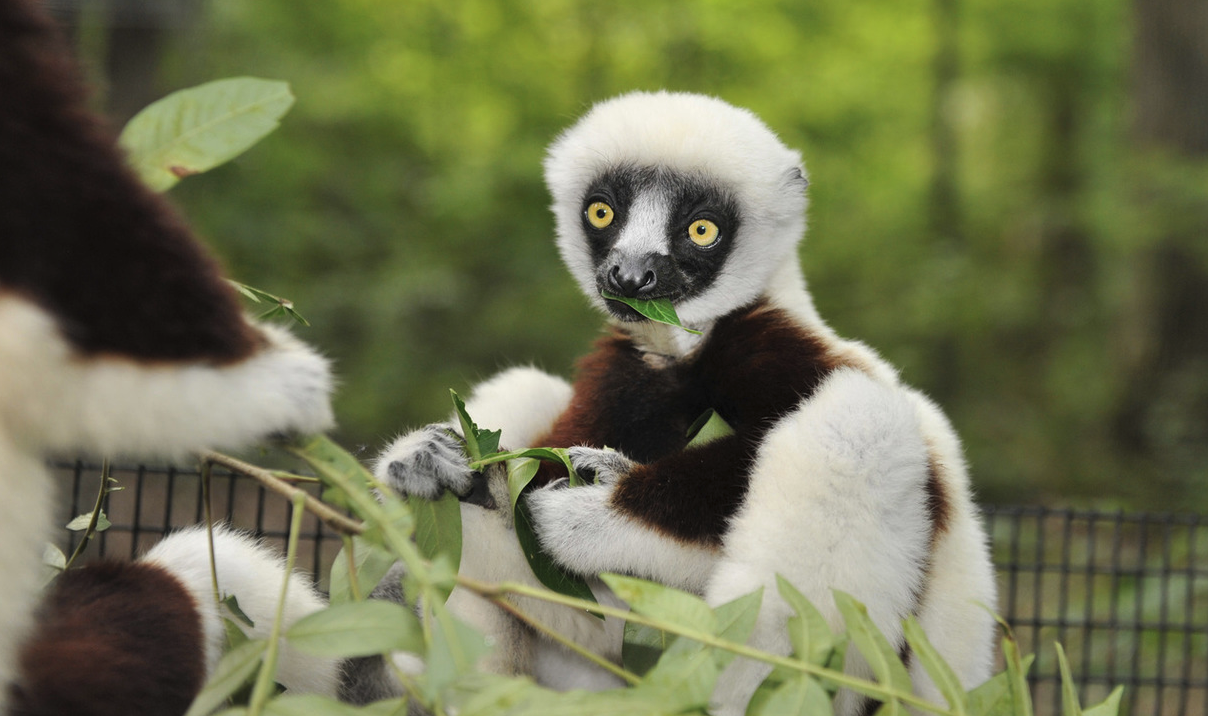By David Fleming. Originally published by Virginia Tech on August 16, 2021. Read the original article HERE.

In the jungles of Madagascar, the threatened sifaka lemur spends most of its days leaping from tree to tree, searching for leaves and fruit in a forest territory that is increasingly in peril.
Halfway across the world, under the watchful care of experts at the Duke Lemur Center, a group of Coquerel’s sifakas are part of a broad effort to ensure that all lemurs — small primates that are native only to Africa’s largest island — will not go extinct.
But what do you feed an animal that is so far from home?
From lemur camp to greenhouse sumac
“My daughter is obsessed with lemurs,” explained Collegiate Assistant Professor Kevin Hamed of Virginia Tech’s College of Natural Resources and Environment. “Several years ago, we found out that the Duke Lemur Center had a summer educational camp, and we had to go.”
While the aspiring lemur scientist was enjoying camp, Hamed, a faculty member in the Department of Fish and Wildlife Conservation, noticed that the center had put out a call for winged sumac trees in the Durham, North Carolina, area.
“Winged sumac is a successional tree that tends to grow in scrubby areas, in places that are cleared for development but not utilized,” said Hamed, who started cultivating winged sumac when he taught at Virginia Highlands Community College. “With the resurgence of development in Durham, I realized that it might be harder to find, so I reached out and said, ‘I think we can grow some of this.’”
The need is significant, as sifaka lemurs, with a unique multicolored fur pattern that makes them a frequent subject in documentaries and children’s television programs, are particularly difficult to care for in captivity.
“They are folivores, or leaf eaters,” explained Charles Welch, the lemur center’s conservation overseer. “They’re difficult to care for because they’re susceptible to gut ailments, but we’ve found that winged sumac is one of their favorite foods. More critically, sumac freezes readily, providing us a useful store of fresh leaves through the winter.” (Learn more about the DLC’s annual sumac harvest.)
As a short-lived plant that grows in transitioning land, access to a steady supply of winged sumac (Rhus copallinum) is a challenge. To help solve the problem, Hamed recruited John Seiler in the Department of Forest Resources and Environmental Conservation to determine if sumac could be successfully cultivated.
“This all started with a hallway conversation,” explained Seiler, Alumni Distinguished Professor and the Hon. and Mrs. Shelton H. Short Jr. Professor of Forestry. “Dr. Hamed mentioned that the Duke Lemur Center needed to propagate winged sumac. I started fiddling around with it and quickly realized that it wasn’t easy to find wild winged sumac seed in the New River Valley.”
Seiler worked to propagate the sumac using cuttings taken from sumac roots and branches and attempting to grow them as new plants. To aid in this effort, Seiler recruited undergraduate student Lesley Merkel to collect samples of winged sumac around campus and grow them in the greenhouse.
“Right now, I’m using two different soil mediums, perlite and a more typical, peat-based soil mix,” explained Merkel, a junior majoring in environmental science in the College of Agriculture and Life Sciences and minoring in forestry. “With those mediums, I’m using three different percentages of growth regulator chemicals to see which is the most effective.”
So far Merkel has found that the twig cuttings collected in the winter root much better in perlite, and she is currently testing the same treatments on summer cuttings. Merkel hasn’t had to go far to collect samples: some winged sumac is growing alongside Cheatham Hall, home of the College of Natural Resources and Environment, and a larger patch is taking root by a pond near the Virginia-Maryland College of Veterinary Medicine building.
Plantings for future generations
For Hamed, who hopes to successfully raise some sumac plants for replanting on land adjacent to the Duke Lemur Center, this effort is an opportunity to demonstrate the ways that urban landscapes can be utilized.
“What this project shows is that you can take a species of plant that is deemed a weed or unattractive and a place like a parking lot or the side of a building, and you can end up with a food resource for an endangered animal,” he said. “Our future is going to be about using our urban spaces to help conservation efforts.”
With 15 lemur species calling the Duke Lemur Center home, a nearby crop of tasty leaves is a valuable resource for the many researchers and technicians working to help conserve animals that are significantly threatened by habitat loss.
“Our center started as a primate research center in the 1960s,” noted Welch, “but we’ve evolved to cover other objectives, including education and conservation. In a normal year, we have 35,000 visitors come through our facility. In addition to that outreach, we’re involved in conservation efforts in eastern Madagascar.”
For the Duke lemurs, the chance to enjoy their favorite leaves makes the collaboration well worth the effort.

